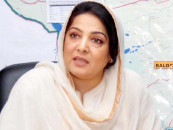Financing development, other key expenses
Efforts needed to enlarge resource envelope through higher investment, economic activity

After every budget, a debate on defence vs development emerges in Pakistan. While I don’t agree with the premise of this debate, after all, Pakistan needs both development and defence. The right question is how should Pakistan finance both its development and defence needs?
Pakistan’s fiscal resources are indeed limited and precarious that need to finance both development and defence expenditures. Under the budget for fiscal year 2020-21, the net revenue receipts are estimated at only Rs3.7 trillion as approximately Rs2.9 trillion will be transferred to provinces out of gross revenues of Rs6.5 trillion.
Interest payments will be around Rs3 trillion. Now, imagine that almost everything else is financed through debt by the federal government. The connection between these two major areas is also discussed during debates on fiscal management and growth.
First, there are discussions that the seventh NFC Award is responsible for the weak macro management at the federal level. Second, there are discussions to enhance the tax-to-gross domestic product (GDP) ratio. I have disagreements on these approaches.
Federal governments in Pakistan – of Pakistan Peoples Party, Pakistan Muslim League-Nawaz and Pakistan Tehreek-e-Insaf (PTI) – in the last decade have not made any serious effort to control their own expenditures on subsidies and state-owned enterprises (SOEs). They have also not worked to improve the value of money for development expenditures.
The federal government has been expanding its footprint from social protection and subsidies to infrastructure development despite scarcity of resources. Many of such initiatives are motivated by political considerations instead of any objective need assessment for public investment.
The situation of development expenditures is also not quite different. Hence, development projects from Neelum-Jhelum extension to water and sanitation schemes need a complete overhaul to derive value for money.
The strategy to just throw monetary resources into half-completed and poorly managed infrastructure projects is not the solution to the lack of development.
Improving investment
When it comes to the recommendation to improve the tax-to-GDP ratio, it is just like putting the cart before the horse. Pakistan’s investment-to-GDP ratio is 15%, which should be increased to around 25% to enhance economic activity in the country.
Currently, the economy is configured around debt-driven growth and consumption. Investment levels are simply insufficient to raise revenues, create jobs, propel economic growth and manage debt in a sustainable way.
If I have to give one performance benchmark to any government, I will consider the investment-to-GDP ratio.
Indeed, each economic growth period in Pakistan is associated with higher inflows of international debt and aid. We need to come out of this vicious cycle.
Pakistan needs to improve human productivity through education, healthcare reforms and enhanced investment-to-GDP ratio through regulatory reforms. Much of this does not require public money. It requires innovative approaches, openness to new ideas in order to alter the way state is functioning and governing the economy.
Three things hold key importance in improving the investment climate in Pakistan for both domestic and international investors. First is to improve commercial contract enforcement. There is a need to reform the archaic legislation and judicial conduct in this area.
Second, there is a need to utilise both private and public land in cities for economic activity, including commerce and housing. Optimal land use in cities will lead to more construction, commerce and revenue generation.
Third, there is a need to undertake reforms in finance and capital markets to channelise savings and investment towards productive sectors of the economy.
It is unfortunate that a country of over 200 million people has only a few thousand active investors in the capital market and only around 500 listed companies.
Why such a poor performance as compared to Thailand, Malaysia, Brazil and Bangladesh? We have instead remained focused on political blame games and vote-seeking development projects.
Right now, many players are fighting for the meagre resource envelope that the country has. Efforts should be made to enlarge the resource envelope through higher investment and economic activity, and improvement in the value of money in development and other expenditures of federal and provincial governments.
We also need to think about the young population of the country and train them to become entrepreneurs to create wealth for themselves and the country. This is the best way to unlock the potential of the youth. Indeed, all actors in the state apparatus need to work together to enhance the resource envelope to finance debt, development and defence needs.
The writer is an entrepreneur, teacher and economic/urban policy professional
Published in The Express Tribune, July 6th, 2020.
Like Business on Facebook, follow @TribuneBiz on Twitter to stay informed and join in the conversation.



















COMMENTS
Comments are moderated and generally will be posted if they are on-topic and not abusive.
For more information, please see our Comments FAQ